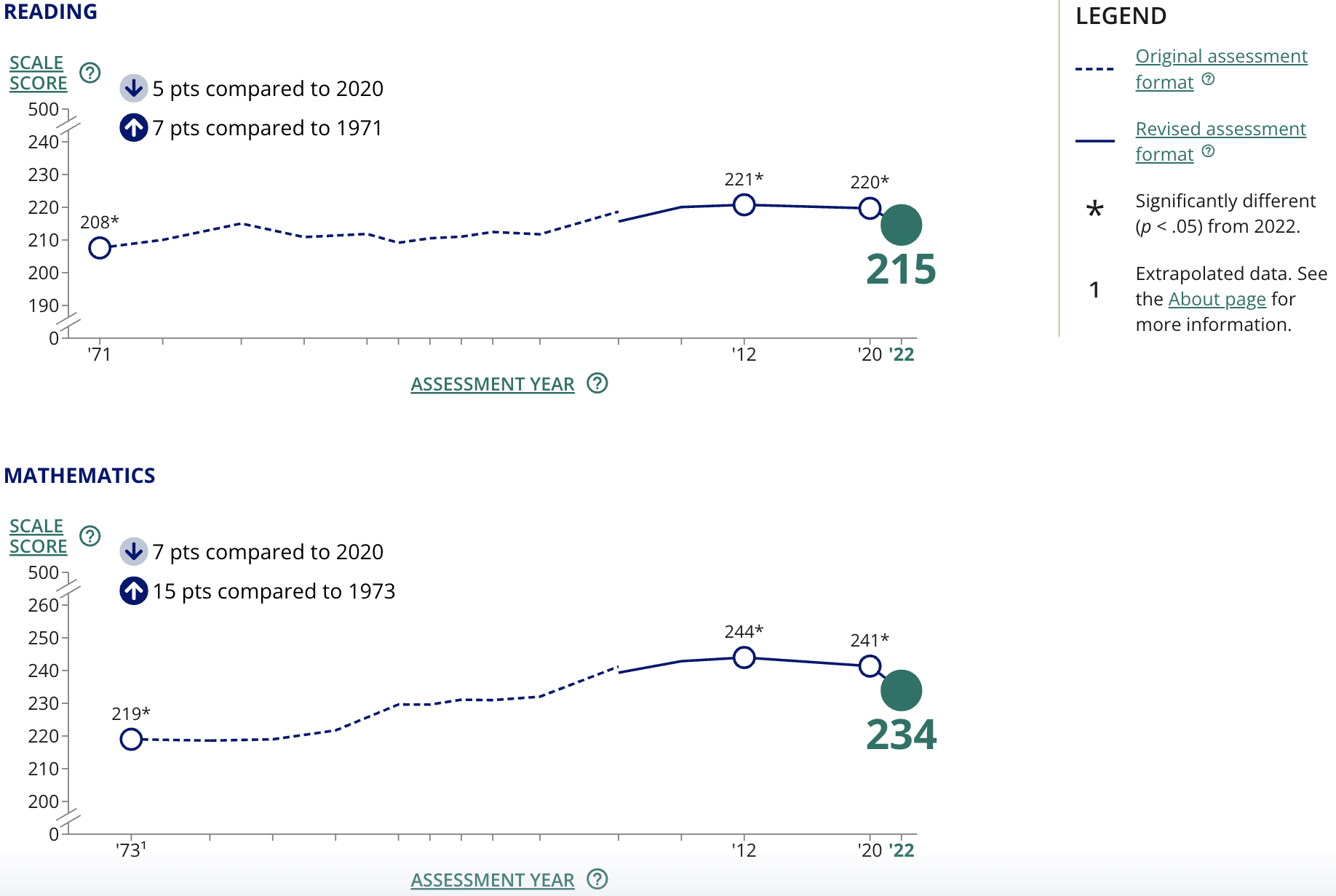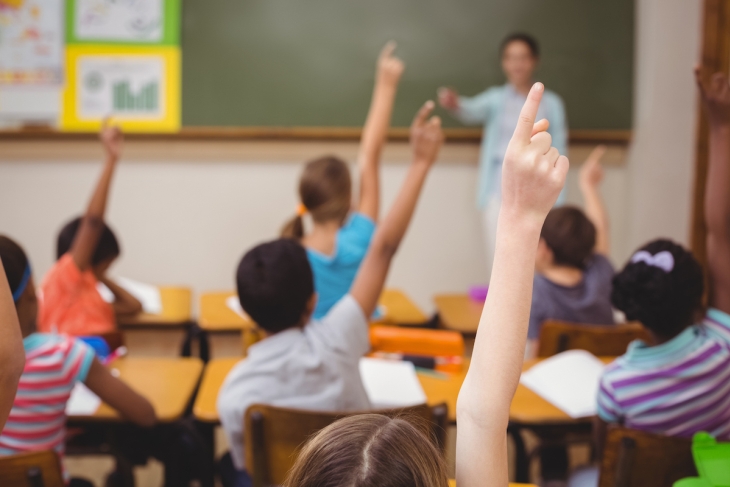When my daughters were preteens, they came home from school one day alarmed. During a lesson on climate change, the teacher or some part of the lesson, it was never quite clear, had basically stated that, absent radical attention to warming, there would be little hope for survivability on earth after 2030. This was during peak Greta Thunberg–mania.
I remember having a few thoughts. First, I’m deeply concerned about climate change, but what was reported to me by the kids isn’t what the evidence shows and is a bananas lesson. But also, even assuming this is what the evidence convincingly shows, these are really young kids. What would be the point of telling them this?
This episode recurred to me recently in the context of the constant, and weirdly fashionable, bellyaching by reformers about how education reform has accomplished little, if anything at all. Oddly, this is one place reformers and anti-reformers now seem to agree, even as the evidence indicates it’s not true. What’s more, even assuming it was in fact the case, if you’re an advocate, why the hell would you run around braying it?
Has everything gone swimmingly? Of course not. But in the context of U.S. social policy, until a few years ago, we were making what would be considered good progress. (It’s worth noting how long social policy change takes in a country like this. Perhaps the recent quite rapid progress on a few issues like gay and transgender rights has skewed perceptions.)
Until the Obama Administration’s and Congress’s decision to throw in the towel on accountability, student achievement was on a steady, if modest, growth path. (See figure 1.) Students furthest from opportunity were making gains. Not enough, but gains. The pandemic, of course, scrambled everything, as did obliviousness by both the Trump and Biden teams, but we should not lose sight of those earlier trajectories—that are averages across an entire student population. People will argue about counterfactuals and the pace of change, but “barely budged,” which you often hear, this is not.
Figure 1. Trend in NAEP long-term reading and math average scores for nine-year-olds

Source: “Explore NAEP Long-Term Trends in Reading and Mathematics,” U.S. Department of Education (accessed April 2024).
Tom Kane, while being perhaps the most passionate voice on the urgency of pandemic learning loss, also suggests that we may have the longer-term story of achievement wrong. A deeper dive he and several colleagues conducted found that “income-based achievement gaps in fourth and eighth grade narrowed between 1992 and 2015—while math scores rose at all income levels.” Similarly, Rick Hanushek and several colleagues found “a steady, albeit modest, reduction in the SES-achievement relationship over the past four decades.” Other data indicate the same thing about low-achievers—notable progress during the standards-era toward what we used to call equity.
Time to throw a party? Nope. The data are all as sobering as they are encouraging. But it does mean the Dante-like, abandon-all-hope approach to talking about educational progress is not only politically stupid whether you’re a reformer, staunch public school supporter, or both—it’s also empirically questionable.
There are plenty of other examples of authentic progress, usually beyond what was promised or expected.
I remember being lectured by the “smart set” in education that KIPP would never have more than fifteen schools and was consequently more or less a distraction I was naïve to even be interested in. (The same people said Teach For America would be perhaps a boutique program of 500 teachers a year if they were really lucky.) By extension, most people thought Bill Clinton’s goal of 3,000 charter schools was just throwaway political hyperbole. Today, there are more than 7,000 charter schools (and about 275 of them are KIPP schools). Are all charters fantastic? No. But many are, and the data show, on average, that they’re getting better and continue to be a good bet as a policy.
More people are going to college, too, and more importantly, graduating. Again, this is not an unvarnished blessing, given the mixed quality and return on investment of higher education, but is also, on average, for the good—especially for low-income students in quality higher education programs.
Standards are also improving. There is plenty to fault in President Obama’s education record, but it seems inarguable that, in aggregate, state standards were better in 2016 than in 2008, and he and Arne Duncan played a role in nudging that along. Standards are also more specific and actionable for teachers and more often aligned with curriculum. We’re also seeing a boom in high-quality curricula hitting the market, and the focus on curriculum is a welcome and noteworthy change. In addition to being good for students, curricular support makes the job of teaching more sustainable.
That’s in part because of another good-news story: We’re finally getting serious about early reading combined with knowledge-rich curricula. The politically fashionable but largely ineffective approaches are being sidelined, and an evidence-based approach to literacy is taking hold. Is this arguably a half-century overdue? Yes. But you can bemoan that or appreciate that late is better than never. It’s still progress.
On all of these issues, we saw a combination government activity, philanthropy, and social entrepreneurs of different sorts. The private sector also played an important role in some key aspects, including innovation. And that activity, for a time, engaged journalists and policy leaders. It was exciting.
If we’re being honest, the biggest barrier to a lot of changes has been and continues to be the constantly changing fads and politics in education. On reading, curriculum, or assessment, too many people figure out what is politically fashionable and proceed from there. I’ve had people tell me that phonics is just a Republican way of teaching reading. That’s idiotic. That sort of ethos is why the gap between evidence and practice is often so substantial and preference falsification is rampant.
This is also the same problem we see now with everyone having the mopes about education improvement and reform. Like those tan shoes with white soles it seems like every dude was suddenly wearing, it’s just the fashionable thing.
It’s remarkable how often you hear at an education meeting that little or nothing has improved in schools, or even that things are basically the same as they were during Jim Crow. It’s complete nonsense, of course. Most people are smart, well-read enough, and aware of the larger world to know this (at least I sure hope that’s the case). Yet it’s the fashion right now to be in that mode. You get socially and professionally rewarded for it even as it’s creating a culture at odds with high expectations and optimism for young people.
We’ve also created a culture where saying there has been progress or things aren’t so bad is likened to being blind to the problems. Progress and continuing challenges are not mutually exclusive. This country and its K–12 sector have made enormous progress—and there is still a lot of work to do.
But, to do that work, you obviously need people to believe it’s possible. That’s why saying there is no progress is insane as an advocacy strategy. Joe Biden is not going to lead a parade, but he’ll get in front of one. So will most pols. But who wants to lead or be anywhere near a parade of Eeyores? Right now, the message to politicians, philanthropy, and media is a dour if not repellent one.
Sure, if you genuinely believe education is not a lever for change or empowerment, then you should go work in a different sector or on different issues. Reasonable people can disagree about the best way to effect change. Otherwise, let’s stop admiring the problems and get back at it with a lot more energy, new ideas, and some fresh arguments and debates.
Here’s the bottom line: Until the one-two punch of ESSA and the pandemic, achievement trends were going in the right direction—especially for students on the wrong end of the achievement gap. And the supports for students, whether new school options or curricula, are improving. There is pent up demand and increasingly supply around innovation.
This is not a bad time to work in education. It should be an exciting time. Reform has hardly been flawless and hasn’t achieved its loftier goals, but at the same time, evidence of progress is all around. This sort of fits-and-starts progress is how social policy change generally happens. In fact, given how stubbornly resistant to change the education system is, how political, and how fad driven, the narrative that nothing has worked is pretty much backwards. We should say so. And then act accordingly.
Editor’s note: A version of this essay was first published on the author’s blog, Eduwonk.




